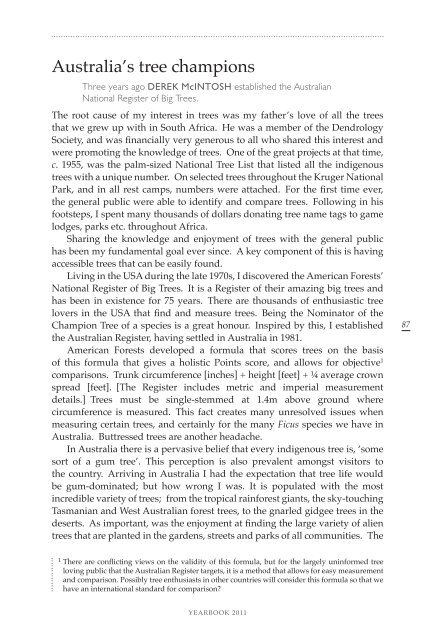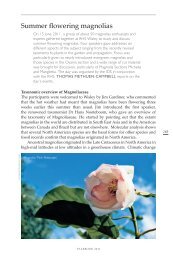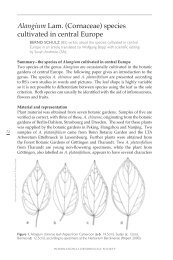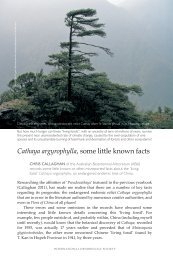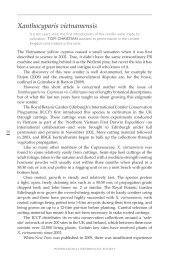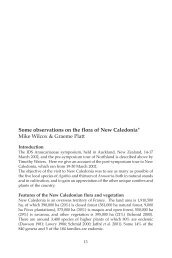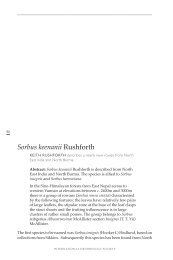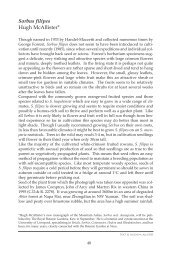Australia's tree champions - International Dendrology Society
Australia's tree champions - International Dendrology Society
Australia's tree champions - International Dendrology Society
You also want an ePaper? Increase the reach of your titles
YUMPU automatically turns print PDFs into web optimized ePapers that Google loves.
Australia’s <strong>tree</strong> <strong>champions</strong><br />
Three years ago DEREK McINTOSH established the Australian<br />
National Register of Big Trees.<br />
The root cause of my interest in <strong>tree</strong>s was my father’s love of all the <strong>tree</strong>s<br />
that we grew up with in South Africa. He was a member of the <strong>Dendrology</strong><br />
<strong>Society</strong>, and was financially very generous to all who shared this interest and<br />
were promoting the knowledge of <strong>tree</strong>s. One of the great projects at that time,<br />
c. 1955, was the palm-sized National Tree List that listed all the indigenous<br />
<strong>tree</strong>s with a unique number. On selected <strong>tree</strong>s throughout the Kruger National<br />
Park, and in all rest camps, numbers were attached. For the first time ever,<br />
the general public were able to identify and compare <strong>tree</strong>s. Following in his<br />
footsteps, I spent many thousands of dollars donating <strong>tree</strong> name tags to game<br />
lodges, parks etc. throughout Africa.<br />
Sharing the knowledge and enjoyment of <strong>tree</strong>s with the general public<br />
has been my fundamental goal ever since. A key component of this is having<br />
accessible <strong>tree</strong>s that can be easily found.<br />
Living in the USA during the late 1970s, I discovered the American Forests’<br />
National Register of Big Trees. It is a Register of their amazing big <strong>tree</strong>s and<br />
has been in existence for 75 years. There are thousands of enthusiastic <strong>tree</strong><br />
lovers in the USA that find and measure <strong>tree</strong>s. Being the Nominator of the<br />
Champion Tree of a species is a great honour. Inspired by this, I established<br />
the Australian Register, having settled in Australia in 1981.<br />
American Forests developed a formula that scores <strong>tree</strong>s on the basis<br />
of this formula that gives a holistic Points score, and allows for objective 1<br />
comparisons. Trunk circumference [inches] + height [feet] + ¼ average crown<br />
spread [feet]. [The Register includes metric and imperial measurement<br />
details.] Trees must be single-stemmed at 1.4m above ground where<br />
circumference is measured. This fact creates many unresolved issues when<br />
measuring certain <strong>tree</strong>s, and certainly for the many Ficus species we have in<br />
Australia. Buttressed <strong>tree</strong>s are another headache.<br />
In Australia there is a pervasive belief that every indigenous <strong>tree</strong> is, ‘some<br />
sort of a gum <strong>tree</strong>’. This perception is also prevalent amongst visitors to<br />
the country. Arriving in Australia I had the expectation that <strong>tree</strong> life would<br />
be gum-dominated; but how wrong I was. It is populated with the most<br />
incredible variety of <strong>tree</strong>s; from the tropical rainforest giants, the sky-touching<br />
Tasmanian and West Australian forest <strong>tree</strong>s, to the gnarled gidgee <strong>tree</strong>s in the<br />
deserts. As important, was the enjoyment at finding the large variety of alien<br />
<strong>tree</strong>s that are planted in the gardens, s<strong>tree</strong>ts and parks of all communities. The<br />
87<br />
1 There are conflicting views on the validity of this formula, but for the largely uninformed <strong>tree</strong><br />
loving public that the Australian Register targets, it is a method that allows for easy measurement<br />
and comparison. Possibly <strong>tree</strong> enthusiasts in other countries will consider this formula so that we<br />
have an international standard for comparison<br />
YEARBOOK 2011
AUSTRALIA’S TREE CHAMPIONS<br />
photograph © Derek McIntosh<br />
88<br />
Eucalyptus melliodora, yellow box, Upper Lurg, Victoria.<br />
Register records indigenous and alien <strong>tree</strong>s.<br />
What makes all of this possible is the internet. I would never have been<br />
able to fund the accumulation of <strong>tree</strong> data and then produce a printed<br />
Tree Register. Even if produced, who would know about it or buy<br />
it The internet allows me to publish the Register on the website: www.<br />
nationalregisterofbig<strong>tree</strong>s.com.au, every few days, and be viewed by<br />
thousands around the world. More important than the cost of the production,<br />
is the zero cost of access for the viewing public. Most incipient <strong>tree</strong> lovers will<br />
INTERNATIONAL DENDROLOGY SOCIETY
TREES<br />
photographs © Derek McIntosh<br />
Above Ficus macrophylla, Moreton Bay fig,<br />
Wauchope, New South Wales.<br />
Right Eucalyptus viminalis, manna gum,<br />
Halls Gap, Victoria.<br />
89<br />
visit a website like this at no cost, but<br />
would never subscribe and pay.<br />
The information in the Register<br />
can be sorted by common name,<br />
scientific name, state, town, and<br />
points. This makes it easy for<br />
Register visitors to locate <strong>tree</strong>s in<br />
specific areas. In the Tree Data<br />
section on the website, a document<br />
can be downloaded that lists full<br />
details of all <strong>tree</strong>s on the Register.<br />
The Register records the national<br />
champion, the state champion, and,<br />
within Queensland & New South<br />
Wales, the regional champion. This<br />
should create a vibrant rivalry<br />
between the states and regions. It<br />
has a practical application too; <strong>tree</strong><br />
lovers can nominate, and visit, their<br />
YEARBOOK 2011
AUSTRALIA’S TREE CHAMPIONS<br />
90<br />
regional and state <strong>champions</strong> without travelling across Australia. Australia<br />
has an area of 7.69 million square kilometres or 2.97 million square miles, with<br />
only 23 million inhabitants.<br />
I remember when I first heard the names of the iconic Australian <strong>tree</strong>s, and<br />
wondered where the Australian Champions were growing Here are some<br />
of them: river red gum (Eucalyptus camaldulensis), 658 points [Watervale, SA];<br />
alpine ash (Eucalyptus regnans), 1087 points [Geeveston, TAS]; Norfolk Island<br />
pine (Araucaria cunninghamii), 400 points [Gerringong & Raymond Terrace,<br />
NSW]; Bunya pine (Araucaria bidwillii), 385 points [Bunya Mountains, QLD];<br />
tallowwood (Eucalyptus microcorys), 615 Points [Dorrigo, NSW]; bloodwood<br />
(Corymbia gummifera), 874 points [Wauchope, NSW]; flooded gum (Eucalyptus<br />
grandis), 652 points [Bulahdelah, NSW.]; ironbark (Eucalyptus paniculata), all<br />
ironbark species champion 319 points [Baulkham Hills, Sydney]; Moreton<br />
Bay fig (Ficus macrophylla), 912 points [Bellingen NSW].<br />
I plan to create an incorporated association or trust that will ensure the<br />
Register remains accessible to all supporters. I do not have a horticultural<br />
background, and rely on a group of expert supporters for advice on all matters<br />
botanical. Dean Nicolle, an internationally recognised authority on eucalyptus<br />
<strong>tree</strong>s, is the principal expert I rely on. Without the <strong>tree</strong> climbing skills of Brett<br />
Mifsud, the heights of many of the enormous Tasmanian and Victorian <strong>tree</strong>s<br />
would remain unverified estimates.<br />
★ ★ ★<br />
INTERNATIONAL DENDROLOGY SOCIETY


